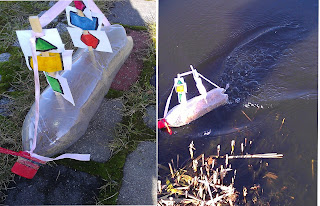Mary 3y. 4m.
Once we went to the
airport to see off our dad, who was going to the business trip. Maria was soo
excited by the view from the window, by the infrastructure of the airport, by
the planes taking off and landing, that I could hardly persuade her to go back
home finally.. had to pay the whole fortune for the parking .. oops..
When came back, we
studied the planes and other means of transport we could find in our kid’s
encyclopedia as well as watched some youtube films on the topic. The buildings
and other city’s infrastructure, however, we studied in a more interactive way.
We build the whole city on the piece of paperboard: organized the traffic with
traffic signs and lights, planted and painted the trees, built houses with
glued windows, parked some cars (everything was done by Maria except me cutting
off the trees and traffic lights, and drawing the roads). She enjoyed building
the city, though less playing with it. The city, however, was valued more by
other kids coming to us.
Another thing we
made was an outside activity, when we were drawing with the chalks. To make it
more interesting there were some tasks for Maria and her friend to fulfill:
1. Maria and our small neighbour Nick were given some paper stuff (e.g.
doctor, airplane, animals etc.). They had to find the right place where to
stick them to:
·
Doctor – hospital (hint: red cross);
·
Animals – zoo (hint: cages);
·
Plane - airport (hint: runways);
·
Vegetables – shop;
·
Train – railway.
2. Had to find and draw waves in the swimming pool.
3. Finish drawing the railway.
4. Draw some traffic lights
Maria added the sun placing it near the airport and other colourful dots saying these are the planets. So, we decided it is no longer an airport but the planetarium and a spaceport.J
 The single most important child rearing practice to be adopted for the
development of emotional and social healthy infants and children is to carry the
newborn/infant on the body of the mother/caretaker all day
long... James Prescott, Ph.D., developmental psychologist
The single most important child rearing practice to be adopted for the
development of emotional and social healthy infants and children is to carry the
newborn/infant on the body of the mother/caretaker all day
long... James Prescott, Ph.D., developmental psychologist





